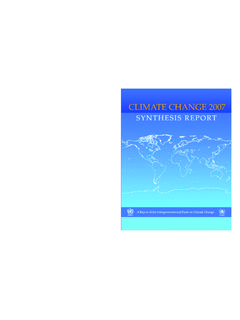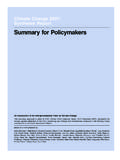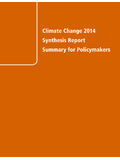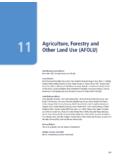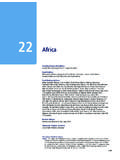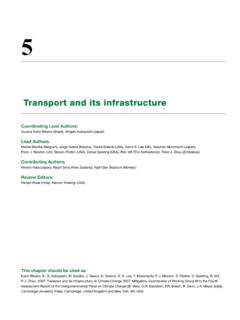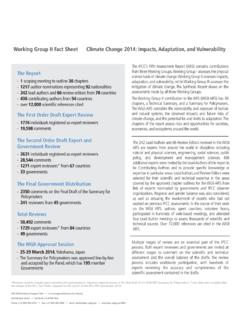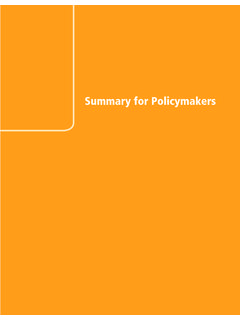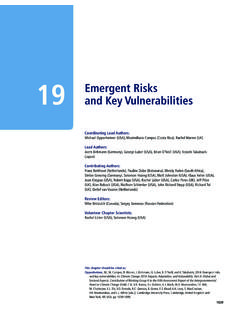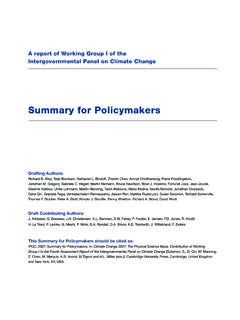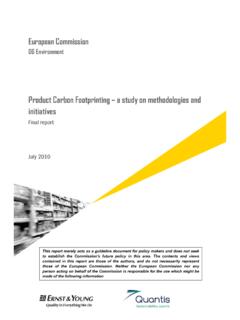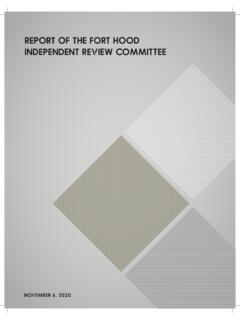Transcription of Performance Parameters - Intergovernmental Panel on ...
1 1329 IIIANNEXT echnology-specific Cost and Performance ParametersEditor:Steffen Schl mer (Germany)Lead Authors:Thomas Bruckner (Germany), Lew Fulton (USA), Edgar Hertwich (Austria / Norway), Alan McKinnon (UK / Germany), Daniel Perczyk (Argentina), Joyashree Roy (India), Roberto Schaeffer (Brazil), Steffen Schl mer (Germany), Ralph Sims (New Zealand), Pete Smith (UK), Ryan Wiser (USA)Contributing Authors:Gesine H nsel (Germany), David de Jager (Netherlands), Maarten Neelis (China)This annex should be cited as:Schl mer S., T. Bruckner, L. Fulton, E. Hertwich, A. McKinnon, D. Perczyk, J. Roy, R. Schaeffer, R. Sims, P. Smith, and R. Wiser, 2014: Annex III: Technology-specific cost and Performance Parameters . In: Climate Change 2014: Mitigation of Climate Change. Contribution of Working Group III to the Fifth assessment report of the Intergovernmental Panel on Climate Change [Edenhofer, O., R.]
2 Pichs-Madruga, Y. Sokona, E. Farahani, S. Kadner, K. Seyboth, A. Adler, I. Baum, S. Brunner, P. Eickemeier, B. Kriemann, J. Savolainen, S. Schl mer, C. von Stechow, T. Zwickel and Minx (eds.)]. Cambridge University Press, Cambridge, United Kingdom and New York, NY, Cost and Performance ParametersAnnex Introduction .. Energy supply .. Approach .. Data .. Transport .. Approach .. Data .. Industry .. Introduction .. Approaches and data by industry sector .. Cement .. Iron and steel .. Chemicals .. Pulp and paper .. Municipal Solid Waste (MSW) .. Domestic wastewater .. AFOLU .. Introduction .. Approach .. Baseline Emission Intensities .. Improved emission intensities .. Levelized cost of conserved / sequestered carbon ..1353 References .. 135413311331 Technology-specific Cost and Performance ParametersAnnex IntroductionAnnex III contains data on technologies and practices that have been collected to produce a summary assessment of the potentials and costs of selected mitigation options in various sectors as displayed in Fig-ure , Table , Figures , , , , , , Figure as well as in corresponding figures in the Technical nature and quantity of mitigation options, as well as data avail-ability and quality of the available data, vary significantly across sectors.
3 Even for largely similar mitigation options, a large variety of context-specific metrics is used to express their cost and potentials that involve conversions of input data into particular output formats. For the purpose of the Working Group III (WGIII) contribution to the Intergovernmental Panel on Climate Change (IPCC) Fifth assessment report (AR5), a limited but still diverse set of sector-specific metrics is used to strike a balance between harmonization of approaches across sectors and adequate consideration of the complexities potentials are approached via product-specific or service-specific emission intensities, i. e., emissions per unit of useful outputs, which are as diverse as electricity, steel, and cattle meat. Mitigation potentials on a product / service level can be understood as the poten-tial reduction in specific emissions that can result from actions such as switching to production processes that cause lower emissions for oth-erwise comparable products1 and reducing production / consumption of emission-intensive costs are approached via different levelized cost metrics, which share a common methodological basis but need to be inter-preted in very different ways.
4 A detailed introduction to the metrics used can be found in the Metrics and Methodology (M&M) Annex (Section ). All of these cost metrics are derived under specific conditions that vary in practice and, hence, need to be set by assump-tion. These assumptions are not always clear from the literature, where such metrics are presented. Hence, comparison of the same metric taken from different studies is not always possible. For this reason, in the AR5 these metrics are generally re-calculated under specified con-ditions, e. g., with respect to weighted average cost of capital, based on underlying input Parameters that are less sensitive to assump-tions. Sensitivities to assumptions made in the AR5 are made explicit. In several cases, however, the availability of data on the Parameters needed to re-calculate the relevant cost metric is very limited. In such cases, expert judgment was used to assess information on costs taken directly from the literature.
5 1 Note that comparability of products is not always given even for seemingly similar ones. For instance, in the case of electricity, the timing of production is crucial for the value of the product and reduces the insights that can be derived from simple comparisons of the metrics used detail on sector-specific metrics, the respective input data and assumptions used as well as the conversions required is presented in the sector-specific sections below. References for data, justifications for assumptions, and additional con-text is provided in footnotes to the data tables. Footnotes are inserted at the most general level possible, i. e., footnotes are inserted at table headings where they apply to the majority of data, at column / row headings where they apply to the majority of data in the respective column / row, and at individual cells where they apply only to data points or ranges given in individual cells.
6 Input data are included in normal font type, output data resulting from data conversions shown in figures and tables mentioned above are bolded, and intermediate outputs are italicized. Energy ApproachThe emission intensity of electricity production (measured in kg CO2-equivalents (CO2eq) / MWh) can be used as a measure to compare the specific greenhouse gas (GHG) emissions of suggested emission miti-gation options and those of conventional power supply technologies. With respect to costs, the levelized cost of energy (LCOE), measured in USD2010 / MWh, serves the same The calculation of LCOE of a technology requires data on all cash flows that occur during its lifetime (see formula in Annex ) as well as on the amount of energy that is provided by the respective technol-ogy. Cash flows are usually reported in some aggregate form based on widely deployed monetary accounting principles combining cash flows into different categories of expenditures and revenues that occur at varying points during the lifetime of the investment.
7 The applied method presents LCOE that include all relevant costs asso-ciated with the construction and operation of the investigated power plant in line with the approach in IEA (2010). Taxes and subsidies are excluded, and it is assumed that grids are available to transport the electricity. Additional costs associated with the integration of variable sources are neglected as well (see Section for an assessment of these costs). 2 The merits and shortcomings of this method are discussed in detail in the Metrics and Methodology Annex of the WGIII AR5 (Annex II). 13321332 Technology-specific Cost and Performance ParametersAnnex IIIAIIIThe input data used to calculate LCOE are summarized in Table 1 below. The conversion of input data into LCOE requires the steps out-lined in the following:Levelized cost (LCOE) in USD2010 / MWheLCOE = I + OM + F ____ E (Equation ) = r ____ 1 (1 + r ) L T (Equation )I = C _ L B t = 1 L B (1 + i ) t ( 1 + d __ (1 + r ) L T ) (Equation )OM = FOM + (VOM REV + d ) E (Equation )E = P FLH (Equation )F = FC E _ (Equation )Where: LCOE is the levelized cost of electricity.
8 Is the capital recovery factor (CRF). r is the weighted average cost of capital (WACC taken as either 5 % or 10 %). I is the investment costs, including finance cost for construction at interest i. C is the capital costs, excluding finance cost for construction ( overnight cost ). In order to calculate the cost for construction, the overnight costs are equally distributed over the construction period. d represent the decommissioning cost. Depending on the data in the literature, this is incorporated as an extra capital cost at the end of the project duration which is discounted to t = 0 (using a decommissioning factor d, as in (Equation )), or as a cor-responding variable cost (dv in (Equation )). d = for nuclear energy, and zero for all other technologies (given the low impact on LCOE). OM are the net annual operation and maintenance costs; sum-marizing fixed OM (FOM), variable OM (VOM), and variable by-product revenues (REV).
9 As a default and if not stated explicitly otherwise, carbon costs (e. g., due to carbon taxes or emission trad-ing schemes) are not taken into account in calculating the LCOE values. E is the energy (electricity) produced annually, which is calculated by multiplying the capacity (P) with the number of (equivalent) full load hours (FLH). F are the annual fuel costs, FC are the fuel costs per unit of energy input, and is the conversion efficiency (in lower heating value LHV). i is the interest rate over the construction loan (taken as 5 %). LT is the project duration (in operation), as defined in IEA (2010). LB is the construction Intensities:For data, see Table below. For methodological issues and litera-ture sources, see Annex II, Section DataTable | Cost and Performance Parameters of selected electricity supply technologiesi, iiOptionsCLBFOMVOMREVFO vernight capital expenditure (excl.)
10 Construction interest) (USD2010 / kW)Construction time (yr)Fixed annual operation and maintenance cost (USD2010 / kW)iiiVariable operation and maintenance cost (USD2010 / MWh)iiiVariable by-product revenue (USD2010 / MWh)Average fuel price (USD2010 / GJ)Min / Median / MaxAvgMin / Median / MaxMin / Median / MaxMin / Median / MaxMin / MaxCurrently Commercially Available TechnologiesCoal PCiv380 / 2200 / 390050 / 23 / 750 / / / Combined Cyclev550 / 1100 / 210040 / 7 / 390 / / / 14 Biomass CHPvi2000 / 5600 / / 101 / 4000 / 0 / 564 / 26 / / cofiringvi,viii350 / 900 / 1800113 / 20 / 200 / 0 / / dedicatedvi1900 / 3600 / / 99 / 5000 / / / , x1000 / 5000 / 1000030 / 0 / 1500 / 11 / 31 Hydropowerxi, xii500 / 1900 / 850055 / 35 / 2500 / 0 / 15 Nuclearxiii, xiv1600 / 4300 / 640090 / 0 / / 13 / / Cost and Performance ParametersAnnex IIIAIIIO ptionsCLBFOMVOMREVFO vernight capital expenditure (excl.
